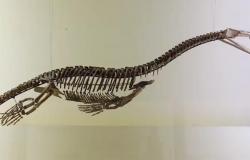Four hundred kilometers north of the Arctic Circle, in the Norwegian port of Kirkenes, there are still those who dream that this sleepy city will one day become an important maritime transportation center. They see it as the western end of a new, faster sea route from China to Europe, made possible by the impact of global warming on the ice-filled waters off the Siberian coast. With the war ravaging Ukraine, this ambition now sounds like fantasy. China’s support for Russia is fueling the West’s distrust of the Asian power’s plans on the “polar silk route”. But China is not withdrawing from Arctic. He continues to see there the opportunity to increase his influence and benefit from the area’s wealth of natural resources.
Rising temperatures in the Arctic are slowly opening up new possibilities for transportation. But geopolitics are changing the region more quickly. Kirkenes feels it strongly. He is only 15 minutes drive from the Russian border. Tourists can enjoy a “king crab safari” that takes them by boat to it, with the eponymous crustaceans caught along the way and cooked for visitors (the huge non-native species was introduced by the Soviets). However, Russians no longer cross to Kirkenes to shop and feast on crabs. On May 29, Norway closed the border crossing to tourists from the other side. The Ukraine conflict has cooled the city. In October, when Russia’s envoy in Kirkenes laid a wreath at a monument to the Soviet troops who liberated the city from the Nazis at the end of World War II, “tensions were in the air,” the newspaper reported. local digital Barents Observer. Kirkenes politicians had urged him not to do so.
In such a climate, it is difficult to imagine how China’s Arctic Silk Road project, unveiled in 2017, could take off. It seemed like a great idea. Using the Northern Arctic Sea Route, shipments from Shanghai to Hamburg could take just 18 days, compared to about 35 days needed for the route through the Suez Canal – or ten days longer than that if diverted around the Cape of Good Hope to prevent attacks by the Houthi rebels in Yemen (there have been dozens against ships in the Red Sea since the war in Gaza began last year).
Kirkenes hoped to sell itself as the first ice-free port where container ships from China would arrive after passing through the Russian segment. They could use it as a place to unload goods on ships that would sail to other ports in Europe. Or they could transfer their goods to trains that would take them much faster to European markets. Chinese businessmen were very interested, says Rune Rafaelsen, who was mayor of Kirkenes from 2015 to 2021. If all this were to happen, northern Europe would go from being a mere “end point” for the flow of goods from China to a “gateway.” entry” for them, enthused Qiushi, the main theoretical magazine of the Chinese Communist Party, in 2019. The “silk road on ice(as China calls its polar transportation plan in Chinese) would become a “new platform” for the Belt and Road Initiative, it said, referring to the country’s streak of building ports, railways, highways and other infrastructure around the world.
A big problem is that Kirkenes has no rail connection to anywhere in Europe. There had been talk of building one with neighboring Finland. Its border is only 50 km away; The line would join the Finnish railway network in the city of Rovaniemi, “the official home of Santa Claus”, 500 km to the south. Even before Russia’s all-out invasion of Ukraine, the Finnish government had chickened out on the matter. In 2019 it published a report expressing doubt that such a line could be profitable, let alone acceptable to the indigenous reindeer herders, the Sami, whose land it would pass through. Now, according to the editor of the Barents Observer, Thomas Nilsen, the Finnish authorities “do not want to subsidize and build a railway line so close to the Russian border”, given the “geopolitical instability” of the area.
Western governments have long been cautious about China’s activities in the Arctic, concerned that the country’s growing economic influence in the region could give it political leverage and open the doors to a Chinese security presence that would add to the challenge. arctic that Russia already poses. Rand, a think tank in Washington, notes that since 2018 China’s “diplomatic activism” in Greenland, an Arctic dependency of Denmark, has decreased. That’s likely the result of successful efforts by Denmark and the United States to block Chinese attempts to invest in sensitive infrastructure and mining there (Greenland hosts a U.S. air base with space surveillance and missile warning systems).
The war in Ukraine has aggravated the West’s skepticism regarding any major project in which China, which proclaims itself neutral but also boasts a “limitless” friendship with China, participates. Russia and provides enormous support to the Russian defense industry. The conflict has caused the freezing of the activities of the Arctic Council, a gathering in which the eight countries with Arctic territory participate and in which China joined as an observer in 2013. (In a 2018 white paper, China called itself a “nearby state to the Arctic”, although its northernmost provincial capital, Harbin, is located on the same latitude as Venice). All council members except Russia are now members of NATO, with Finland and Sweden having joined the defense pact in the past 15 months. In Arctic affairs, China finds itself even more on the sidelines.
The frustration this has caused in China is evident. In Russian Studies, In a Chinese academic journal, two Chinese academics, Yue Peng and Gu Zhengsheng, wrote in February that Russia was weakening in the High North. “The original balance of the Arctic has been broken, and the balance in the Arctic region is tipping towards Western countries.” China’s image in the region, they said, faced “a significant risk of decline.” This could have a “huge negative impact on China’s future involvement in Arctic affairs,” the academics suggested.
Russia controls almost half of the Arctic coastline and a large part of its oil and gas reserves. For now, Chinese ships cannot use the Northern Sea Route (Russia charges heavy fees for the use of its icebreakers). Shippers prefer predictable schedules: despite the warming of the Arctic, journey times can vary due to ice and fog. However, Chinese companies see advantages in Russia, which is turning to Asia to compensate for the loss of Western markets. Among them, participation in the construction of ports, oil and gas projects and the construction of ships so that Russia can navigate these resources to the east (China is a large buyer of Russian energy). In the past, Russia may have been reluctant to allow China to participate in the development of its Arctic coast. Now he welcomes Chinese aid. “Russia is very interested in having them, because it has no other options,” says Kjell Stokvik of the Upper North Logistics Center in Kirkenes. “So, in a way, for China they are in a very good situation.”
There are risks, as Yue and Gu pointed out, such as the consequences of Western sanctions. They urged China to be “prudent and discreet” in its approach to Arctic cooperation with Russia. However, during a visit by the Russian leader, Vladimir Putin, to Beijing in May, the two countries committed to “promote the Arctic route as an important international transport corridor” and encourage their companies to “strengthen cooperation to increase the volume of traffic on the Arctic route and build logistics infrastructure to the arctic route. The Silk Road on ice is slippery, but retains its charm.
© 2024, The Economist Newspaper Limited. All rights reserved.






